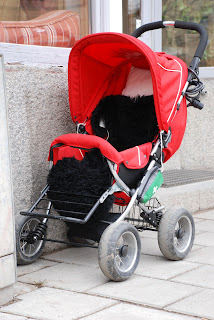Shots from Apartment to Office by Bike
Stockholm and the surrounding area and most other places I've been in Sweden is riddled with bike paths (a good thing!). Many adults use bikes to run errands and commute to work. Most bikes are "urban" bikes and many are old are left outside, sometimes locked to a gutter or fence. The subway stations and train stations have bike parking areas. It's not unusual to see a 50 or more bikes at these stations.
The first time I tried to bike from Norrmalm to my Kista office, I got lost several times despite having a good bike path map. The ten mile route was easily fourteen. Coming back I made half the mistakes so it was maybe 10 miles. That was last weekend.
Today I tried again and made it in 45 minutes. I used paths not on the trail map.
Most of the route is city with large office buildings and city traffic. However, the bike path does have excursions into the stereotypical Swedish pastoral scenes: the signature earth-tone painted homes and wooded areas. This post shows some shots from my bike commute. It begins with a smart car parked outside my apartment with "Have you got a job?" in Swedish painted on it.
The second photo is one of two small communities on the way. The homes are small, probably 300 square feet and yet they all seem to have small gardens, many have small vegetable greenhouses. These are not typical of Swedish homes, however. More typical homes are in the next collage of photos.
You notice that the bike commute goes by water. In this case it's part of the Baltic sea. The Baltic close to Stockholm is calm by sea standards. It's almost like a lake and not very salty. Everything in Stockholm is close to water, either the Baltic or lake Mälaren. Lake Mälaren and the Baltic are separated by a lock (a sluice) at Slussen (I think that's Swedish for "the sluice"). Boats can use the lock to go between the two bodies of water. I think they lock desgn prevent salt water from entering the lake.
The sailboats are still mostly stored for the winter - on shore under plastic (maybe a photo later). I have noticed more and more boats showing up in the docks near Gamla Stan.
The last picture is of the largest tree mulcher I've ever seen. It was being used to clear a swath through the forest for something. Another bike trail? A power line? I don't know.





































